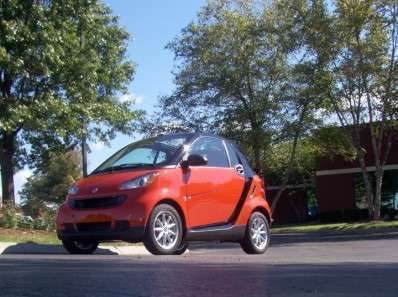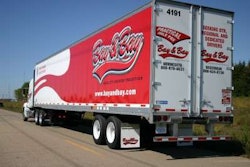 Averitt gave away this Smart Car, a 40-mile-per-gallon car sold through Mercedes-Benz dealerships, to one lucky associate whose team or facility showed measured improvement in conservation and efficiency. Another 20 associates won a $500 gas card.
Averitt gave away this Smart Car, a 40-mile-per-gallon car sold through Mercedes-Benz dealerships, to one lucky associate whose team or facility showed measured improvement in conservation and efficiency. Another 20 associates won a $500 gas card.As diesel and gasoline both approached $5 a gallon last summer, conservation became the topic of discussion in boardrooms and at kitchen tables across America. Prices have cooled today, but executives and associates at Averitt Express nonetheless have put their awareness into action through a companywide incentive program.
“We wanted to do something that would get associates’ attention and bring focus to the topic of conversation,” says Brad Brown, marketing and communications leader for the Cookeville, Tenn.-based company. “We wanted to do something that would make a splash.”
Averitt executives crafted a new team-based incentive program that gave all associates the chance to win a 2008 Smart Car – a new compact car sold through Mercedes-Benz dealerships that averages 40 mpg – or one of 20 $500 gas cards.
“We want to do everything we can to reduce waste, improve efficiency and transform ourselves into a leaner, greener and more competitive team than ever before,” says Scott Wolf, vice president of corporate services. “We’re challenging everyone on our team to pursue conservation and efficiency with renewed vigor – and if they help us improve, they might drive off in a new car or get several free tanks of gas as a reward.”
To be eligible, associates were to help reduce their facility’s use of resources – fuel, water, electricity and paper – over a period of three months, from November 2008 to January 2009. This month, the winners of the Smart Car for Smart Thinking program were to be selected randomly from all eligible associates.
Establishing measurements
As a large less-than-truckload and truckload transportation and supply chain management provider, Averitt employs thousands of associates at more than 100 company facilities.
At Averitt, a “facility” isn’t just a brick-and-mortar building. The term also is used interchangeably for teams or groups of associates that work at a single location or with an individual business unit. Examples of facilities include the corporate office and LTL service centers; they also include the supply chain solutions staff, a group of truckload drivers assigned to a dispatcher, and teams that work onsite at customer locations.
The aim of the program was to establish measurements for resource usage that each facility was to improve upon over a three-month period – and set new baselines or targets they were expected to meet.
“A lot of thought and planning went into making it realistic,” Brown says. “It was not as simple as just taking the previous three months. The whole point was to make it achievable, realistic and a challenge.”
Before launching the program last November, Averitt promoted it throughout the third quarter of 2008 as management worked with associates to establish the key benchmarks that each team and facility needed to improve relative to prior periods.
“It’s been a companywide initiative,” Brown says. “It started at the top. Our president was very involved in it. Every level of leadership, from executive to individual service center, helped in creating the measurements and making them realistic.”
Money well spent
Brown declined to say how much the Smart Car cost the company, but a Smart Car retails for about $11,000 to $14,000. Even after adding $10,000 worth of gas cards and the cost of administering the program, the expense was minor compared to the potential savings for a fleet of Averitt’s size, Brown says.
To achieve these savings, associates were not expected to follow formal programs handed down by upper management; Averitt facilities were given complete latitude. “The idea was, ‘Let’s challenge folks and let their creativity and innovation go to work,’ ” Brown says. “We didn’t give any rules.”
Fuel, the most expensive resource, was the biggest target. As such, associates have focused most of their attention on reducing engine idling. Team leaders have talked to drivers about the importance of conserving fuel, and the company also uses technology that measures idling and other fuel usage statistics on each tractor. “It is easy to see driver performance and provide daily coaching,” Brown says.
“Even though the price of fuel has gone down recently, 2008 showed us just how quickly fuel prices can skyrocket,” Wolf said. “That’s why we still want to do our part to reduce our use of fuel. It makes us less vulnerable to possible fuel price spikes like the ones we’ve seen in the past, and it’s just the right thing to do for our environment.”
Besides curbing fuel usage, the program has promoted excitement and sharing of ideas among facilities to save other resources. Without being prodded, associates have turned off air conditioning and opened doors. They have worked with landscaping companies to reduce watering and check for leaks. They have turned off lights and opened blinds.
With the additional savings from reducing electricity, water and paper usage, the program is “really a no-brainer if you look at justifying it,” Brown says. “There is the hard data that you have on actual cost, but that is just a piece of it.” What isn’t measured is the amount of attention the program receives, as well as the focus it brings to forming habits that will continue well after it’s over, he says.
Because of the program’s success, the company likely will take a similar approach in creating another incentive program in the future. Averitt probably will seek further reductions in the resources it measured for this program and include others as well, Brown says.
Smart initiatives
The Smart Car for Smart Thinking program is the latest of a number of green initiatives that have saved Averitt millions of dollars. Since 2004, the company has been a charter member of the U.S. Environmental Protection Agency’s SmartWay transport partnership. Since joining SmartWay, Averitt estimates savings of 2.5 million gallons of diesel and reduction of carbon dioxide emissions by 26 percent.
While cost reduction has been the primary focus of the company’s green initiatives thus far, other benefits are more far-reaching, Brown says. Like many carriers, Averitt has seen a lot more “green” interest from customers. They ask Averitt’s salespeople about the company’s environmental policies, and bid packages include questions such as “Are you a SmartWay member?”
But customers asking about Averitt’s green initiatives aren’t only interested in protecting the environment. “They want to feel good that you are doing everything you can to keep your costs low,” Brown says.
Innovators profiles carriers and fleets that have found innovative ways to overcome trucking’s challenges.
If you know a carrier that has displayed innovation, contact Avery Vise at [email protected] or 800-633-5953.








